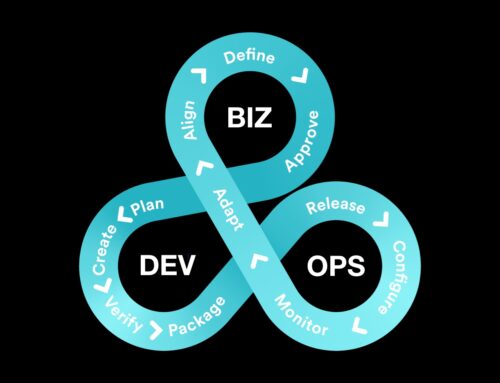In today’s fast-paced software market, companies are always under pressure to deliver high-quality software products and services to meet the ever-changing demands of their customers. With the increasing complexity of software systems and the need for rapid innovation, traditional software development methods are no longer sufficient.
This is where DevOps comes into play. As a groundbreaking approach that bridges the gap between development and operations teams, DevOps is revolutionizing the software development lifecycle by enabling faster, more efficient, and more reliable application development and deployment.
In this article, we will explore the core principles and benefits of DevOps, discuss how it streamlines the development and deployment process, and explain how this innovative methodology is transforming the software industry. By understanding the impact of DevOps on application development and deployment, businesses can harness its power to improve efficiency, reduce time-to-market, and ultimately, deliver better products and services to their customers.
Before we begin with understanding how DevOps speeds-up application development, let us first understand how the DevOps development process falls into a software lifecycle.
The DevOps software development life cycle

DevOps has revolutionized the software development life cycle (SDLC) by offering an efficient and streamlined approach compared to traditional methods. It achieves this by promoting close collaboration between the historically separate development and operations teams.
Let’s explore the key stages of the DevOps application development process.
1. Planning
The planning stage involves discussing project requirements, features, and functionalities for the application. At this stage, DevOps practitioners adopt agile project management tools, such as Kanban boards, to facilitate team alignment and enhance collaboration. This organized and well-communicated approach lays a solid foundation for the entire project.
2. Development
DevOps emphasizes transparency and collaboration during the development stage, enhancing the product’s value. This approach enables efficient execution of tests, integrations, and reviews. Numerous DevOps automation tools accelerate the development process without compromising quality, leading to a more agile and responsive software development cycle.
3. Delivery
The delivery stage commences when the software reaches a secure, robust, and enforceable production environment. Here, the operations team in your DevOps solutions takes the lead, evaluating the software product and its value. This stage also allows processes to become scalable and efficient.
4. Software Maintenance
The maintenance stage involves continuous monitoring and bug resolution to ensure optimal user experiences. The DevOps team proactively addresses user feedback and experiences in real-time, embodying the fail-fast philosophy. This stage is crucial for delivering the best possible outcomes.
So far, we’ve explored various aspects of DevOps practices, including their benefits, automation in software development, and the DevOps software lifecycle.
All of these aspects contribute to the acceleration of the development timeline, making DevOps an invaluable approach in the software industry.
How DevOps accelerates application development and deployment?
DevOps practices come with capabilities that accelerate the development process without sacrificing product quality and efficiency. Here are eight ways how DevOps-driven automation in application development makes the process effective.
Automation
Undoubtedly, software development process automation is the industry’s future and one of its biggest trends. DevOps enables the incorporation of automation into the software lifecycle.
Using this approach, real-time project modifications occur after the repository triggers actions through automation. For instance, when developers change a code, it pushes a build, triggering automatic software deployment.
Thus, DevOps aids in automation by significantly increasing the development lifecycle’s efficiency. This process enhances development, deployment, and quality assurance for your software.
Continuous integration and continuous delivery
Continuous integration (CI) allows developers to make code modifications without altering the core code. Meanwhile, continuous delivery automates software deployment, facilitating constant updates at a fixed frequency for every application version entering production.
Utilizing DevOps CI/CD services ensures regular code deployment while continuously addressing bugs and adding new features.
Improved builds
Effective, error-free builds result from collaboration between development and operations teams. This collaboration considers crucial factors such as performance, security, features, reliability, and reusability. Teams working together toward the same goal – building efficient software – can develop and deploy products more quickly.
Infrastructure as code
Infrastructure as code, an automation DevOps solution, facilitates rapid software delivery. It provides all necessary resources for software development in a descriptive and manageable manner.
This approach reduces human errors through automation, resulting in a safe and optimized process. Additionally, configuration management tools can be used to align servers, databases, system resources, and virtual machines.
Version control
Version control becomes more efficient with DevOps implementation. It allows developers to review version history and track change revisions. This process aims to facilitate code analysis and recovery when revisions are needed. With software codes merging into the same file, changes become optimized, and multiple people can work simultaneously.
Agile software development
Although the Agile vs DevOps debate has persisted, the industry is finding ways to merge them. The agile-powered DevOps approach emphasizes teamwork and end-user involvement, continuously seeking improvements and making real-time changes to address problems and meet customer expectations.
User Experience (UX)
When UX teams and developers don’t collaborate, poor experiences may result. Similarly, if the operations team addresses a product’s user experience at the end of the cycle, developers must make code changes that affect the entire codebase.
DevOps software development circumvents these time-consuming and costly errors by fostering collaboration between designers and developers.
Conclusion:
These are just some of the ways DevOps expedites and enhances the software development process. Integrating DevOps practices and merging development and operations have become the secret behind global software success.
When implemented correctly, DevOps can revolutionize software functionality and adaptability to ever-changing market demands. However, embracing DevOps requires significant organization-wide changes in work processes and culture.
This is why only 10% of businesses succeed in deploying software using this model. However this does not have to be your experience. DevOps can offer transformative benefits and a competitive edge.
Need help getting started? Contact our team for DevOps consulting services. We can help you establish a foundation for collaboration, better planning, and faster software deployment – all while aligning with market needs.









